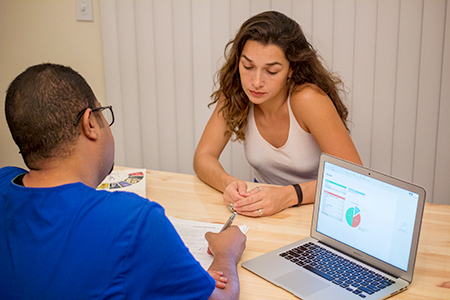 Lunesta is a brand name of eszopiclone, a prescription sleep aid. Eszopiclone is a hypnotic drug, meaning that it slows brain activity in order to promote sleep. Lunesta is often used on a short-term basis to treat insomnia. Many people use Lunesta without experiencing any serious complications, but some people who use Lunesta for an extended period of time, even for legitimate purposes, become physically dependent on the drug, and this can lead to addiction. Many people who are addicted to Lunesta originally received the drug through legitimate means, but some users are introduced to sedatives like eszopiclone as street drugs.
Lunesta is a brand name of eszopiclone, a prescription sleep aid. Eszopiclone is a hypnotic drug, meaning that it slows brain activity in order to promote sleep. Lunesta is often used on a short-term basis to treat insomnia. Many people use Lunesta without experiencing any serious complications, but some people who use Lunesta for an extended period of time, even for legitimate purposes, become physically dependent on the drug, and this can lead to addiction. Many people who are addicted to Lunesta originally received the drug through legitimate means, but some users are introduced to sedatives like eszopiclone as street drugs.
Lunesta abuse typically takes the form of taking a higher dosage of the drug than prescribed, or using the drug more often than instructed to by a doctor. Some people chew the tablets in order to release the dose of Lunesta more quickly. Rarely, an individual may crush and dissolve the tablets with water to inject the solution.
It is common for Lunesta abuse to begin as self-medication; an individual may misuse the drug in order to treat symptoms of insomnia that have not been resolved. You should never take a higher dose of Lunesta than instructed by your doctor. If your insomnia is not fully controlled by your prescription, talk to your doctor about other treatment options available to you.
Occasionally, a person may abuse Lunesta for recreational purposes. Eszopiclone was found to cause euphoria at certain doses, according to a study published by the journal Neuropsychiatric Disease and Treatment, which can lead to its abuse. You may be more likely to develop an addiction to Lunesta if you have a history of drug abuse or addiction.
Effects of Lunesta Abuse
According to NIDA, drugs like Lunesta slow brain activity by increasing levels of a neurotransmitter called gamma-aminobutyric acid (GABA) within the central nervous system. High levels of GABA cause brain activity to slow and decrease, which produces a calming effect and promotes sleep. Depressants first affect parts of the brain that control conscious actions, like movement and speech, according to California State University at Long Beach. If the dosage is increased, these drugs will begin to affect the brain’s automatic processes. This causes heartbeat and respiration to slow, among other effects.
Drug abuse can have severe and lasting effects on the brain and body. Addiction can change the chemical makeup of the brain, making stopping use of the drug very difficult. Long-term abuse of any substance can do irreparable damage to major organs; the heart, lung and liver are put under strain when forced to process drugs on a frequent basis, which can lead to organ damage with chronic use.
Even at therapeutic doses, eszopiclone can cause side effects. These effects can be much more severe if Lunesta is abused. Side effects of eszopiclone, according to the National Library of Medicine, include:
- Headache
- Pain
- Daytime drowsiness
- Lightheadedness
- Dizziness
- Loss of coordination
- Nausea and vomiting
- Unpleasant taste
- Dry mouth
- Heartburn
- Unusual dreams
- Lowered sexual desire
- Painful menstrual periods in women
- Breast enlargement in men
More severe side effects are more likely if Lunesta is abused. These side effects can include:
- Hives, rash, or itching
- Swelling of the face or extremities
- Difficulty breathing or swallowing
- Hoarseness
An overdose of Lunesta can cause extreme drowsiness or coma.
Withdrawal and Detox
Use of eszopiclone should be stopped gradually. Individuals who abuse Lunesta often build up a tolerance, meaning they must take more and more of the drug to achieve the desired results. If you are taking large doses of Lunesta, it is very important that you do not stop taking the drug too suddenly. If this drug is being used under the guidance of a doctor, you will probably be instructed to lower your dosage slowly over several days. This helps to prevent any withdrawal symptoms if physical dependence has occurred.
Withdrawal from central nervous system depressants like Lunesta can be severe. Withdrawal symptoms, according to the National Library of Medicine, may include the following:
- Anxiety
- Strange dreams
- Stomach and muscle cramps
- Nausea and vomiting
- Sweating
- Shakiness
- Seizures
Some people who stop using Lunesta experience a “rebound” syndrome. This typically involves a return of symptoms previously controlled by the drug, including anxiety and difficulty sleeping. The sudden increase in brain activity when stopping use of a hypnotic drug can also occasionally cause seizures, according to the National Institute on Drug Abuse (NIDA).
Because use of Lunesta must be stopped gradually, it is recommended that detox take place in a medically supervised environment. Withdrawal from eszopiclone can cause severe symptoms, so it is best to stop using the drug under a doctor’s supervision, so any medical complications can be properly addressed.
Treating Lunesta Addiction
 Once medical detox is complete, further treatment for an addiction to Lunesta is required in order to avoid relapsing back into drug use. It is not uncommon for people who are addicted to sedatives like Lunesta to also abuse other drugs, including other sedatives like alcohol. Effective treatment needs to recognize all substance abuse issues present, as well as any co-occurring mental health disorders and any physical diseases.
Once medical detox is complete, further treatment for an addiction to Lunesta is required in order to avoid relapsing back into drug use. It is not uncommon for people who are addicted to sedatives like Lunesta to also abuse other drugs, including other sedatives like alcohol. Effective treatment needs to recognize all substance abuse issues present, as well as any co-occurring mental health disorders and any physical diseases.
NIDA recommends that treatment for an addiction incorporate several steps, including detoxification, behavioral counseling, medication if appropriate, treatment of any co-occurring disorders, and long-term follow-up care to prevent relapse. There are currently no FDA-approved medications to treat an addiction to Lunesta or similar drugs. A tapered approach is generally used for detox, and other medications can be used to address specific symptoms of withdrawal.
Treatment primarily takes the form of behavioral interventions and therapy. Counseling helps to motivate individuals to abstain from drug use and engage fully in the treatment process. Therapy often focuses on changing unhealthy thought and behavior patterns, and teaching new life skills and coping techniques. The skills learned in therapy help the individual stay sober when faced with triggers and life stresses.
There are many types of therapy that have been shown to be effective in treating addiction. Common therapy modalities include Cognitive Behavioral Therapy, Contingency Management interventions, the Community Reinforcement Approach, Motivational Enhancement Therapy, the Matrix Model, 12-Step facilitation therapy, and Family Behavior Therapy. The best method of therapy varies between individual situations and preferences; what is right for one person may not be right for someone else. Many people try more than one treatment approach before they find the most effective approach for their situation.
Continued Care
Addiction recovery is a highly individualized process. It often requires a lifetime of continuing treatment, though the intensity of that treatment lessens over time. Lunesta addiction can take over an individual’s life, but with dedication and proper treatment, lasting recovery is possible.
